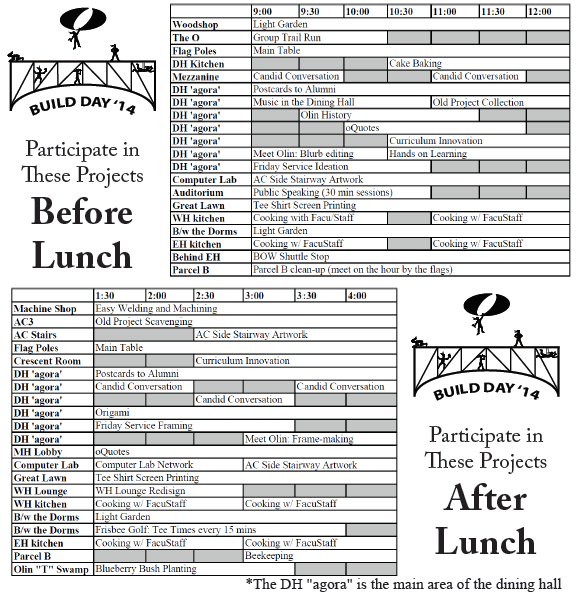Olin, this article is your call to action. This article is your mandate to do something. To make a difference. To have an impact! It’s up to you to take personal responsibility to better your environment, and I invite you to start right away. Tomorrow is Build Day, when Faculty, Students, Staff, and Alumni are invited to celebrate the Olin Community together. It will be a great chance for you to put your change-making abilities to the test!
I challenge you to make the most of this opportunity. Learn about the projects in advance, and make an effort to engage with every one that interests you. Use the schedule below to plan out your time. Consider the two overarching values that led to Build Day: that our community is worth investing in and that each and every one of us can create something beneficial if we decide to. Take the initiative, and introduce yourself to a member of the community you haven’t met yet – Faculty, Student, Staff, or Alum! Support the Project Champions who have invested time and energy into creating an experience for you – one that will also benefit the college. And then, think about this: you, too, can be a part of creating the next Build Day. You can identify a worthwhile project, propose it to the Build Day Architects, and work with them to make it a reality. You can even help run the show next year! Speaking from experience, it’s a vastly rewarding endeavor. You don’t even have to wait for next year’s Build Day – Oliners who care are turning their visions into reality all the time. At Olin, you can do this and more, if you want to. I know you have ideas.
We are all successful when we work with others, learn from each other, and give back to one another. I know that it’s not always easy to act, but still, I implore you to! Try something. Experiment! If you do it ‘right,’ your experiments may take on a life of their own! Getting started is the hard part.
So how do you transform your ideas into reality? The first step is to talk with as many people as you can. Find out who has tried them before, who would care about them now, and who would be affected by their implementation. These are your stakeholders. Explain your vision to them. Justify your idea, and let them help you come up with solutions. Anticipate a way for your project to gracefully and cleanly fail. One way to do this is to frame it as an experiment. Another way is to make it impermanent. For instance, Sanjoy’s sticky-note wall of approximation has lasted years. It succeeds in its goal of demonstrating student work, but it can be replaced quickly and easily if necessary.
Here’s an example of the process in action: years ago, a Fundamentals of Business and Entrepreneurship (FBE) team planned an art exhibit in the dining hall. They got community approval of the artwork, asked facilities to okay the installation, and then gave it over to the people in charge of the space. Because they took strides to lay the groundwork for their piece, we are able to enjoy the giant painting above the clocks to this day. On the other hand, last year, a group of students invented #livephoenix – a screen affixed to a bar in the dining hall that automatically displayed the tweets of Oliners. Despite being a perfectly compelling creation, #livephoneix soon ended up dismantled, outside the Mail Room. The project was cleared away because its creatrs hadn’t communicated properly with the people responsible for the space. So, just before a high-profile campus event, facilities had no way to know who to contact, and choice but to remove it themselves. I still think about that project occasionally; about how easily it could have been rebuilt, and how it might have been reinstalled in a more sensible way, so that we might still be using it now. The key message? Get feedback.
Once you’re done getting feedback, don’t then wait around for authorization! We construct this imagined decision-maker in our minds who passively judges our proposals until they magically crystallize to perfection. Someone who then steps in and grants us her permission to act. But there is no ultimate stamp of approval. In reality, if you reach out to all of the relevant parties (and all of the people they suggest you contact as well), and you satisfy their doubts and implement their requests, there’s no one else to go to.
In a community as small as Olin’s, we frequently find problems without point-people. The bland Milas Hall Mezzanine was one, until Steve Brand went through the process I’ve just described, and arranged for an installation of student-built vehicles to live there over the summer. The aforementioned FBE team brought art to our common space. #livephoenix tried to address issues in communication. Nobody asked these people to solve these problems, but everyone benefited from their work. As Oliners, we face a unique blend of challenges (due to our size) and opportunity (due to our newness). I challenge you to pick a problem that you care about. And I urge you to try to fix it! Remember this: You, the person who cares enough about an issue to propose a solution to it, are as valid an authority to make it happen as anybody could be. Check in with the stakeholders, and get them to help you. Then, do something.
